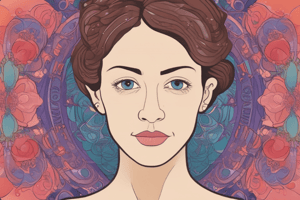Podcast
Questions and Answers
What marks the beginning of menopause?
What marks the beginning of menopause?
- Last menstrual period (correct)
- Cessation of ovarian follicular activity
- Onset of menstrual irregularity
- Loss of estrogen production
Which hormone is produced by the dominant follicle?
Which hormone is produced by the dominant follicle?
- Testosterone
- Estradiol (correct)
- Androstenedione
- Progesterone
What is the primary function of the hypothalamic-pituitary-ovarian axis?
What is the primary function of the hypothalamic-pituitary-ovarian axis?
- Maintenance of urogenital health
- Regulation of metabolic changes
- Control of reproductive physiology (correct)
- Modulation of vasomotor symptoms
What is the expected change in circulating FSH levels during menopause?
What is the expected change in circulating FSH levels during menopause?
What is the primary effect of loss of estrogen production on the body?
What is the primary effect of loss of estrogen production on the body?
What is the diagnosis of menopause based on?
What is the diagnosis of menopause based on?
What is the primary role of inhibin-B in the body?
What is the primary role of inhibin-B in the body?
What must be excluded before diagnosing menopause?
What must be excluded before diagnosing menopause?
What is the primary goal of treatment for menopausal symptoms?
What is the primary goal of treatment for menopausal symptoms?
Which of the following non-pharmacologic therapies is recommended to alleviate mild vasomotor symptoms?
Which of the following non-pharmacologic therapies is recommended to alleviate mild vasomotor symptoms?
What is the contraindication for using combined hormonal contraceptives in perimenopausal women?
What is the contraindication for using combined hormonal contraceptives in perimenopausal women?
What is the most effective treatment for moderate and severe vasomotor symptoms, impaired sleep quality, and vulvovaginal symptoms of menopause?
What is the most effective treatment for moderate and severe vasomotor symptoms, impaired sleep quality, and vulvovaginal symptoms of menopause?
What is the benefit of estrogen-only therapy in 50- to 59-year-old women with a history of hysterectomy?
What is the benefit of estrogen-only therapy in 50- to 59-year-old women with a history of hysterectomy?
What is the role of HRT in preventing osteoporosis-related fractures?
What is the role of HRT in preventing osteoporosis-related fractures?
In women with an intact uterus, what is the composition of HRT?
In women with an intact uterus, what is the composition of HRT?
What is the composition of conjugated equine estrogens?
What is the composition of conjugated equine estrogens?
Flashcards are hidden until you start studying
Study Notes
Perimenopause and Menopause
- Perimenopause begins with menstrual irregularity and ends 12 months after the last menstrual period, marking the beginning of menopause.
- Menopause is the permanent cessation of menses caused by the loss of ovarian follicular activity.
Clinical Presentation
- Symptoms of perimenopause and menopause include:
- Vasomotor symptoms (hot flushes and night sweats)
- Sleep disturbances
- Depression
- Anxiety
- Poor concentration and memory
- Vaginal dryness and dyspareunia
- Headache
- Sexual dysfunction
- Arthralgia
- Urogenital atrophy in menopause and dysfunctional uterine bleeding
- Metabolic changes occur due to the loss of estrogen production, including:
- Increase in central abdominal fat
- Effects on lipids, vascular function, and bone metabolism
Pathophysiology
- The hypothalamic−pituitary−ovarian axis controls reproductive physiology.
- Follicle stimulating hormone (FSH) and luteinizing hormone (LH) regulate ovarian function.
- Gonadotropins are influenced by negative feedback from sex steroids.
- As females age, circulating FSH progressively rises, and ovarian inhibin-B and anti-Mullerian hormone decline.
- In menopause, there is a 10-to-15-fold increase in circulating FSH, a 4-to-5-fold increase in LH, and a greater than 90% decrease in circulating estradiol concentrations.
Diagnosis
- Menopause is determined retrospectively after 12 consecutive months of amenorrhea.
- FSH on day 2 or 3 of the menstrual cycle greater than 10−12 IU/L indicates diminished ovarian reserve.
- Altered thyroid function and pregnancy must be excluded.
Treatment
- Goals of treatment include relieving symptoms, improving quality of life, and minimizing medication adverse effects.
Non-Pharmacologic Therapy
- Mild vasomotor and/or vaginal symptoms can be alleviated by:
- Lowering the room temperature
- Decreasing intake of caffeine, spicy foods, and hot beverages
- Smoking cessation
- Exercise
- A healthy diet
- Mild vaginal dryness can be relieved by non-estrogenic vaginal creams or local/systemic estrogen therapy.
Pharmacologic Therapy
- Combined hormonal contraceptives (CHCs) provide contraception and vasomotor symptom relief but have contraindications.
- Hormone replacement therapy (HRT) is the most effective treatment for moderate and severe vasomotor symptoms, impaired sleep quality, and vulvovaginal symptoms of menopause.
- Estrogen-only therapy may decrease heart disease and all-cause mortality in 50- to 59-year-old women with a history of hysterectomy.
- HRT is effective for prevention of osteoporosis-related fractures in recently menopausal women at risk.
- In women with an intact uterus, HRT consists of an estrogen plus a progestogen.
Studying That Suits You
Use AI to generate personalized quizzes and flashcards to suit your learning preferences.



